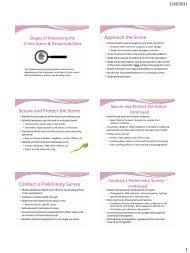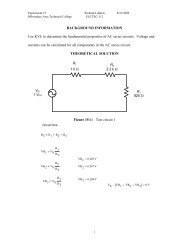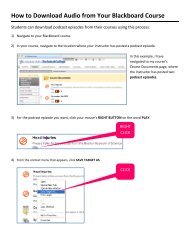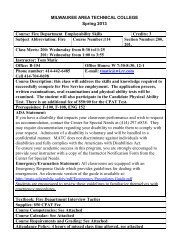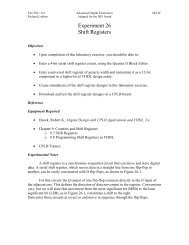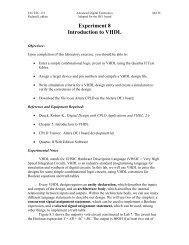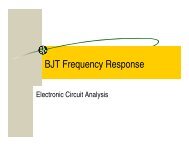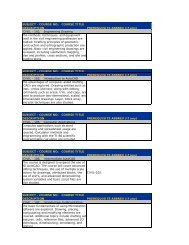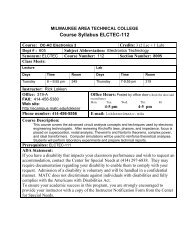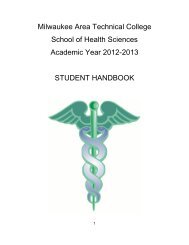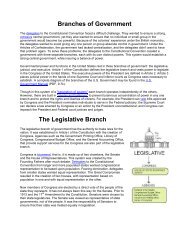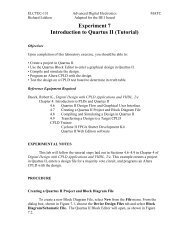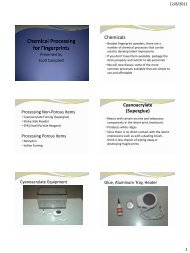WI Forward Award 2012 - Welcome to MATC - Milwaukee Area ...
WI Forward Award 2012 - Welcome to MATC - Milwaukee Area ...
WI Forward Award 2012 - Welcome to MATC - Milwaukee Area ...
Create successful ePaper yourself
Turn your PDF publications into a flip-book with our unique Google optimized e-Paper software.
Workforce Focus: Category 5<br />
5.2.a(3) Performance Management<br />
<strong>MATC</strong> values of Integrity, Excellence, and Accountability are<br />
the foundation for our workforce performance management<br />
systems. The Human Resources Division has five units<br />
responsible for supporting high-performance work, workforce<br />
engagement, compensation, and incentives: Certification,<br />
Compensation and Benefits, Employee Relations, Labor<br />
Relations, and Wellness. Each provides specific human resources<br />
services <strong>to</strong> the college, and the HR Division offers links and<br />
information <strong>to</strong> each of these units on the internal website.<br />
The <strong>MATC</strong> Men<strong>to</strong>ring Program is a formal partnership among<br />
non-represented employees for the transmission of knowledge<br />
<strong>to</strong> support career and professional development for the<br />
college’s talented and emerging leaders, and annual surveys are<br />
conducted. Wellness Program’s mission is <strong>to</strong> improve the quality<br />
of life for <strong>MATC</strong> employees by providing programming that<br />
meets a wide range of personal health needs.<br />
Compensation personnel work <strong>to</strong> meet the needs of <strong>MATC</strong><br />
employees and the short- and long-term goals of the district.<br />
The compensation system ensures that employee earnings are<br />
consistent with the terms of the five contractual agreements.<br />
The earnings of employees not in bargaining units are<br />
measured against annual survey data provided by the College<br />
and University Professional Association. Evaluations promote<br />
internal equity between jobs, classify individuals for increases<br />
in their assigned responsibilities, and compensate individuals<br />
for acquiring and demonstrating higher-skill levels. When jobs<br />
are reclassified, established pay guidelines or bargaining unit<br />
contracts dictate rates of pay. Benefits provide 40 - 45 percent of<br />
employees’ <strong>to</strong>tal compensation. The health, dental, life, and longterm<br />
disability insurance plans are comparable <strong>to</strong> those of other<br />
technical colleges (Figure 5-1d).<br />
Workforce reward and recognition occurs formally through the<br />
President’s monthly Communiqué newsletter, distributed <strong>to</strong> the<br />
<strong>MATC</strong> community online and posted on the website. Personnel<br />
achievements are also recognized at Convocation at the beginning<br />
of each semester, and at campus, divisional and/or department<br />
meetings. An annual Employee Recognition Banquet celebrates<br />
those employees reaching miles<strong>to</strong>nes. Retiring employees, 25-<br />
and 35-year employees, and 50-semester part-time employees<br />
are recognized yearly. Internal recognitions are also given in a<br />
variety of annual celebrations for participation in AQIP activities,<br />
the United Way campaign, the <strong>MATC</strong> Foundation, and Grants.<br />
For performance evaluations of tenured faculty, a new Peer<br />
Coaching System began in 2009 that is aligned with the<br />
<strong>MATC</strong> Standards of Teaching Excellence. These standards<br />
were created by a joint administration-faculty work team and<br />
include: Understanding Students and Fostering Student Success;<br />
Classroom Management; Planning and Organization; Teaching<br />
Methodology; Assessment of Student Learning; Content Mastery<br />
and Currency, and Professional Contributions. A self-assessment<br />
focusing on these standards, along with feedback that can include<br />
student course evaluations, is used <strong>to</strong> create a Teaching Action<br />
Plan (TAP). Faculty are given the opportunity and encouraged<br />
<strong>to</strong> find and work with other faculty <strong>to</strong> achieve their annual<br />
goal(s). These individual action projects reinforce the faculty<br />
commitment and focus on student success in the classroom.<br />
Performance evaluations for non-represented employees,<br />
including administration, are conducted on an annual basis<br />
with no connection <strong>to</strong> compensation or continued employment<br />
outside of the probationary period. This performance process is<br />
focused on accomplishing the mission of the college, creating a<br />
shared vision, and fostering employee growth and development.<br />
The performance appraisal process provides an opportunity<br />
for the employee <strong>to</strong> plan and assess performance goals and <strong>to</strong><br />
identify and work on areas for continuous improvement. The<br />
three phases <strong>to</strong> the process are 1) a collaborative effort by the<br />
supervisor and employee <strong>to</strong> identify strategic and professional<br />
development goals focusing on the employee’s work and aligning<br />
it with the department’s strategic goals and objectives; 2) an<br />
attempt <strong>to</strong> accomplish these goals by the employee, and 3) an<br />
annual follow-up and assessment of the employee’s progress.<br />
5.2.b ASSESSMENT OF WORKFORCE<br />
ENGAGEMENT<br />
5.2.b(1) Assessment of Engagement<br />
Figure 5-2a shows the alignment between <strong>MATC</strong>’s strategic<br />
goals with the focus of the PACE categories as they best<br />
represent how workforce engagement is assessed.<br />
Some departments have created additional incentives for<br />
their workers. For example, members of Local 715 and the<br />
paraprofessionals of Local 212 earn compensation for low<br />
absenteeism. Employees from Local 587 are rewarded for low<br />
absenteeism with compensation time and a gift card. Total<br />
reported sick hours by staff are tracked annually, with declines<br />
registering between 2007 and 2011.<br />
5.2.b(2) Correlation with Organizational Results<br />
We believe that when the faculty, staff, and administra<strong>to</strong>rs are<br />
productive, they are effective in helping students learn, the<br />
primary function and mission of the college. In part, the SSI<br />
and PACE surveys measure employee and college effectiveness<br />
(Figures 7-1s and 7-2a; Figures 7-3d through 7-3h).<br />
5.2.c WORKFORCE AND LEADER DEVELOPMENT<br />
5.2.c(1)(2) Learning and Development<br />
System and Effectiveness<br />
<strong>MATC</strong> employee learning and development systems are linked<br />
<strong>to</strong> the college’s mission, vision, values, and strategic goals.<br />
The aim of Professional Development is <strong>to</strong> provide course<br />
and seminar opportunities for <strong>MATC</strong> employees for skill<br />
development, professional development, and personal growth.<br />
By investing in employee development, <strong>MATC</strong> advocates the<br />
philosophy of lifelong learning and its commitment <strong>to</strong> providing<br />
educational opportunities <strong>to</strong> all employees (Figure 7-3j; 7-3l).<br />
In addition, the American Federation of Teachers Educational<br />
Research and Dissemination (ER&D) Program is a unionsponsored,<br />
research-based professional faculty development<br />
program. In 2011, <strong>MATC</strong>’s chapter of ER&D merged its space<br />
with the Faculty Resource Center, allowing for a larger “teaching<br />
and learning center” for full- and part-time faculty, staff, and<br />
administration reflective of the school’s shared-governance<br />
culture. This center also has a cyber-presence on facultynet,<br />
<strong>MATC</strong>’s intranet. For the first time, a <strong>2012</strong> survey of all faculty<br />
29



